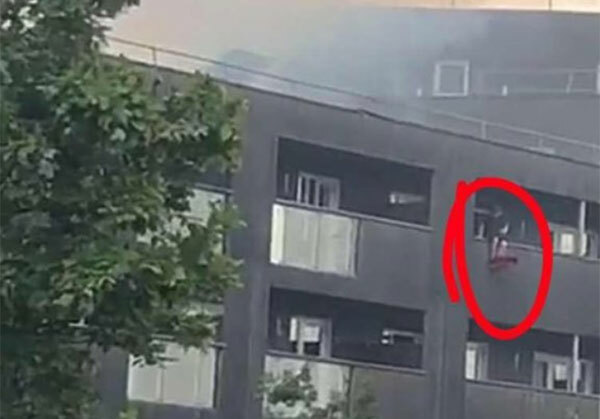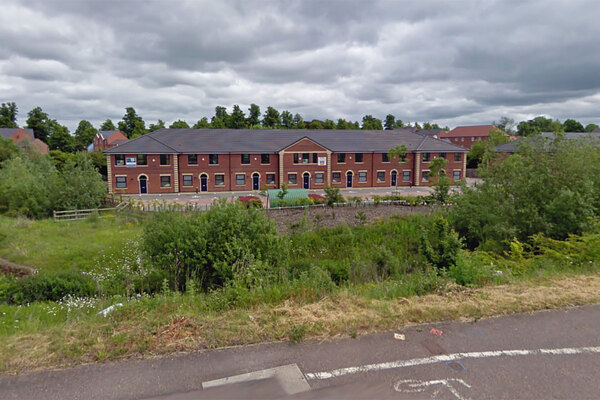Barking fire: the inside story
Earlier this summer, almost exactly two years after Grenfell, a fire ripped through a block of flats in east London. Residents tell Jack Simpson what happened that day and how it could have been avoided
“It was any normal Sunday. We had just been for a walk, and were back at home relaxing. That was when my husband saw the flames,” says Candy Cheung, who lived on the top floor of Samuel Garside House in Barking, east London.
As soon as they saw the flames, Ms Cheung and her husband picked up their children and began their escape of the four-storey block, knocking on neighbours’ doors as the couple fled.
Moments later, Ms Cheung found herself rooted to the spot outside, watching the inferno rip through her first home. Realising she had no contents insurance, she stood clutching her one-year-old daughter, tears rolling down her face.
“All those years that you work hard, and then your flat is gone in literally minutes,” she says.
Three months on, many residents are still without a home, left to pick up the pieces of lives drastically changed on that Sunday afternoon in June – nearly two years to the day after the Grenfell Tower fire.
Luckily, and somewhat remarkably, no one was killed at Barking. But it still shows how little has been learned since 72 people died in the disaster in west London.
Just as at Grenfell, residents at Samuel Garside House were failed before the fire. And, as rehousing efforts falter and issues with the building continue to emerge, the trauma and anger continue long after the incident.
The Samuel Garside block is part of the Barking Riverside regeneration in east London. It is described in marketing material as “Barcelona on Thames”, and the temperature on the afternoon of 9 June was akin to that of the Catalan capital.
Many of the development’s residents were outside enjoying the good weather, including some on their balconies. And it was on one of these balconies that the fire broke out.
Eyewitnesses have told Inside Housing that it was a fallen barbecue on one of the lower levels of Block C that sparked the blaze. The London Fire Brigade (LFB) has recorded the cause as undetermined, with probable causes being the unsafe disposal of cigarettes, the unsafe use of a barbecue, or a flame coming into contact with flammable materials.
Within minutes, flames took hold of the timber balcony and spread to adjoining flats. Those looking at the fire from outside could immediately see that a disaster was happening. But those in the building were unaware.
Residents say that no fire alarm went off to alert them of the danger. This is not unusual. In blocks of flats, it is common to adopt a ‘stay put’ policy with no plan B, which means no alarms are fitted. Residents also reported issues with the smoke ventilation system, which is supposed to clear corridors of smoke. It was only because of people shouting outside the block and others knocking on doors when escaping that many knew what was going on at all.
Video of the fire at Samuel Garside House, in Barking, on 9 June, captured by resident Rav Sahota
Rav Sahota, who lived on the top floor of the block with his wife Sonia and their two children, was in when he heard a loud bang on his door.
“It was Candy and she looked worried. At first I thought it must be something wrong with the kid, but then she said ‘fire’,” he says. “When you hear ‘fire’ you just don’t think. We picked up the kids and just ran.”
He describes arriving at the third floor to a scene of panic as residents tried to escape. The situation was exacerbated by magnetic doors that refused to open. “The doors were jammed; people were struggling to open them,” Mr Sahota says.
In a residents’ meeting just days after the fire, survivors described having to “break open the block’s magnetic doors” in a desperate bid to help people escape.
For other residents, by the time they realised there was a fire, it was too late to use the doors.
Steven Quinn was in his apartment at the back of the building. Unaware of what was going on, he was drawn to his balcony by what he thought were children fighting.
“It was only when I went out to the balcony and a man and woman were shouting ‘there is a fire’ that I realised I had to leave,” he says.
Putting his pet cat, Calypso, in his box, Mr Quinn went to leave through his front door but was confronted by smoke.
Above: Steven Quinn escaping the blaze
Realising that the only way to escape was via the balcony, he began a death-defying descent to safety, initially climbing on to a neighbour’s balcony two doors across, and then, with cat-box in hand, down from the third floor.
He and Calypso were lucky – a number of pets perished in the fire.
Carmen Niculae, who was in her second-floor apartment when the fire started, recalls seeing large bits of wood falling when she eventually exited the building.
“It felt like you were part of a stunt in a movie. You never think you would go through anything like this,” she says.
The fire service was first called at 3.31pm and the first fire engine arrived in five minutes. One hundred firefighters followed. But they had problems locating a fire hydrant, with eyewitnesses claiming that it was poorly marked. Instead, firefighters had to connect to a hydrant in a street close by, eating into crucial time. Videos of the fire show that hoses were not directed at the building for around six minutes.
Shortly after the fire, London mayor Sadiq Khan confirmed that the fire brigade “initially experienced problems locating an appropriately marked fire hydrant”. However, he claimed that “water supply was not a significant issue” as crews had tanks on their engines.
But he added that the incident does “point to a wider problem for the UK fire and rescue service”. While there is no statutory obligation around clear marking and provision of fire hydrants – and the fire brigade does not have a status in law to consult or challenge these designs – it is an issue the LFB has raised in the review of building regulations currently being led by the government.
Bellway Homes, the developer of Samuel Garside House, told Inside Housing that all hydrants were installed and marked to agreed specifications and certificated.
The LFB got the fire under control by 6pm, but serious damage had already been done. According to Bellway, a total of 20 flats had fire damage, with eight requiring more than six months of restoration work. Two people were treated for smoke inhalation.
As those affected tried to make sense of what had happened, questions began to be asked about why the homes were built the way they were.
Above: The inside of Ms Cheung’s home after the blaze (picture: Candy Cheung)
Barking Riverside is a multibillion-pound regeneration project driven by Barking Riverside Ltd, a joint venture between L&Q and the Greater London Authority. Samuel Garside House was built by Bellway in 2014 and sold to Adriatic Land, part of the £1.6bn Long Harbour Ground Rent Fund.
As freeholder, Adriatic Land is responsible for fire safety. The management of the block is carried out by Adriatic’s subsidiary HomeGround, which then employs RMG, a subsidiary of Places for People, for day-to-day management.
When you visit Barking Riverside, what distinguishes Samuel Garside and its neighbouring blocks is their wooden cladding and balconies.
“Since Grenfell two years ago we have been raising these concerns with the main developer [about the cladding],” Venilia Amorim, treasurer of Barking Reach Residents’ Association, told Inside Housing the day after the fire.
It emerged after the fire that the cladding was Thermowood – a Class D fire-rated timber that is far more combustible than the Class B-rated materials required for buildings over 18m.
But this points to a serious flaw in building guidance: Samuel Garside is under 18m, so there were no restrictions on the combustibility of the cladding that could be used.
Above: How the block looked before the fire
According to those present on the day, it took less than five minutes for the fire to spread across balconies. This is despite Bellway saying it believed that the cladding and the material on the balconies should have resisted fire spread for at least 30 minutes.
In a highly charged residents’ meeting after the fire, Ian Gorst, regional chair for London and the South East at Bellway, was asked why the wood had not met this expectation. He said that the speed with which the fire took hold across the timber was “clearly unacceptable and something it needed to address”. However, he added that the building as a whole had performed as designed.
Mr Gorst vowed that the company would take steps to replace all balconies and cladding. Bellway also said it would look to treat existing wood to enhance its fire resistance.
Nearly three months on, Bellway has yet to submit its planning application for the cladding replacement but says it is in the final stages of consultation. And when asked to confirm whether the wood had been treated, it said it had taken the decision to focus on a permanent solution to replace all timber decking instead. This is estimated to take between six and nine months.
During the same meeting, Hugh McGeever, managing director at RMG, revealed that a fire risk assessment (FRA) of the block had been carried out in January. He told anxious residents that the report showed that the building was “fully compliant” and that no risks with the balconies were identified.
But this was not the full story. Less than a week later Inside Housing would uncover the FRA, revealing that the manager had been warned that the external cladding and deck balconies posed a “significant hazard” that could put residents at risk of smoke inhalation and burn injuries.As if describing what happened on the day, the report added that if a balcony did catch fire, it could “accelerate fire spread through… setting the balcony above alight”.
Above: An RMG director is questioned at a meeting
RMG would later clarify that the assessment was split into risks and management actions and that there were no “risks” and only two “management actions” identified in the report, making Mr McGeever’s comments accurate at the time.
This was the first time residents had seen the FRA and were made aware of the warnings.
“You never question these things – you trust the people looking after the block,” says resident Sonia Sahota. “We’ve lost complete trust.”
And if residents felt out of the loop and powerless before the fire, this feeling continued as efforts to rehouse them faltered in the weeks and months afterwards.
In the immediate aftermath of the fire, the majority of displaced residents moved in temporarily with neighbours or hotels paid for by the council and insurers.
However, as weeks passed, the insurers and the building managers began to put forward the idea of a return to the apartments.
In a letter sent to private leaseholders on 16 July, RMG told them that their homes were now habitable, and that residents would no longer have their alternative accommodation covered by the insurer.
In response, leaseholders carried out a protest outside Barking and Dagenham Council’s offices, demanding not to be sent back until they were confident the block was safe.
In the days following the protest, residents were informed by RMG that their cover would be extended by a week. Then followed a period during which RMG and HomeGround arranged and then changed several ‘move back’ dates for leaseholders.
One resident currently living in a hotel tells Inside Housing that she had been given three different dates in the space of three days for when funding would stop, something she says caused “a huge amount of stress”.
“We have literally put our lives on hold. We didn’t know where we were going to be week-to-week,” says Ms Niculae, who spent much of July moving between hotels across east London.
Above: The aftermath of the fire (picture: Nathaniel Barker)
The situation came to a head at the end of July when the date of 2 August was given for leaseholders to move back in.
On 30 July, a letter was sent by Edwards Duthie Shamash, the solicitors representing the residents, saying that the managers had yet to provide evidence that the building was structurally safe and demanding that the accommodation cover was extended until the end of August within 24 hours. The next day, a new date of 2 September was given.
Insurers have now agreed to continue to cover alternative accommodation until a council inspection of the block deems it safe, which is expected in late October.
Yet while private leaseholders have managed to secure alternative accommodation until such a time, social housing tenants have not.
Within Samuel Garside House, 32 apartments are owned by housing association Southern Housing, mainly across blocks A and B, which were not directly damaged by the fire.
Despite a number of concerns about the safety of the Samuel Garside development, including the safety of the cladding, nearly all of the social housing residents were moved back in by 12 August.
Kavita Rana, partner at Edwards Duthie Shamash, who is representing residents of Samuel Garside, says it is alarming that Southern Housing residents have been sent back even when serious hazards are still being discovered on the blocks.
“I think it is scandalous they have been pressured to go back when there was no adequate assessment. The fire should have been a wake-up call – it is as bad then as it is now.”
Above: Scaffolding around the development two months after the fire
One Southern Housing resident, who preferred not to be named, tells Inside Housing: “It was like Southern Housing was saying, ‘Your place is fine; there is nothing else we can do for you.’ But we all know this place isn’t fine.”
Chris Harris, executive director of customer services at Southern, says that although none of the properties occupied by Southern Housing’s tenants were actually directly damaged by the fire, the landlord understands how upsetting the evacuation and aftermath have been for residents.
He adds: “I can assure you that no one has been forced to return. Our priority is always the safety and well-being of our residents. To suggest otherwise is simply wrong.
“The parties responsible for the building, its management and the fire safety measures undertook several risk assessments, including a Type 4 fire risk assessment, and swiftly acted on any recommendations.”
“My daughter doesn’t want to go in the lift just in case the building catches on fire. She was never like that before”
Southern Housing resident
The Southern resident, who has been living in the property for several weeks now, says that he has not gone back out on his balcony since the fire, and that the events of that day are still having an impact on his family.
“My daughter doesn’t want to go in the lift just in case the building catches on fire. She was never like that before,” he says.
He has sought medical help because of his difficulties sleeping. “They tried to give me sleeping tablets, but I said I don’t want anything that can knock me out just in case I can’t get my kids out,” he says.
The trauma caused by the fire is evident when speaking to all those evacuated from the building.
Ms Niculae has been going to group therapy sessions with other residents since the fire, while another resident, Constantin Gherjic, has been going to one-on-one sessions. Children living in the area have also been offered counselling.
Meanwhile, issues with the block continue to be unearthed. A housing health and safety rating system inspection was completed at the end of August. However, while the full report is due in late October, Barking and Dagenham Council has already identified three hazards, including unsafe glass on three balconies, that present a falling hazard.
The inspection also found that 21 of the temporary fire doors installed after the fire were not fire safe. All these issues have now been rectified.
A council spokesperson says it was “alarmed by the initial findings” of the inspection, adding that it is now pushing the building manager to allow residents to return only when assessments show that the building is structurally safe.
A spokesperson for HomeGround says: “We are co-operating fully with the council’s investigations. Even though the building is safe, we appreciate some residents still have concerns, which is why temporary accommodation has been extended until the council’s inspections are complete.”
The strain on those still picking up the pieces from the fire continues. Ms Cheung says that her three-year-old daughter has been very unstable since the incident. “At one point she was running around recalling what happened, and was hiding under a table and shouting, ‘Quick, mum, there’s a fire,’” she says.
Mr Sahota says that he is very grateful he escaped, but that he cannot help think what might have happened if the fire had been at another time of day. “It was just how quick it went up,” he reflects. “It was just so lucky it was in the day and everybody was up. If it was at night, well, it’s game over, isn’t it?”




















